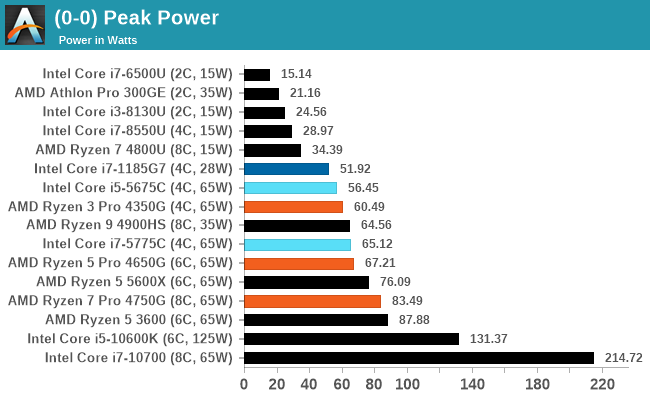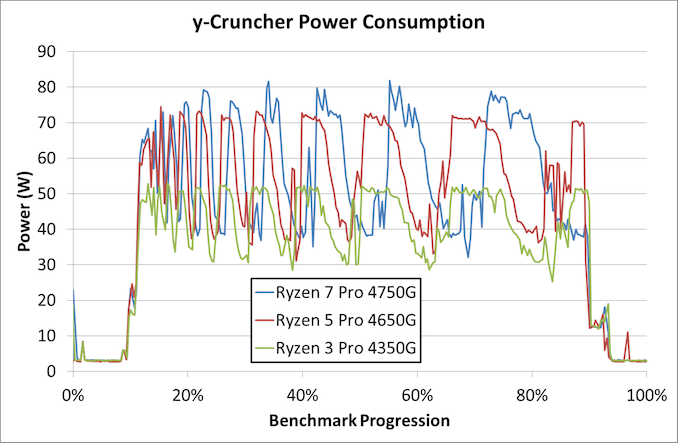Testing The World’s Best APUs: Desktop AMD Ryzen 4750G, 4650G and 4350G
by Dr. Ian Cutress on December 16, 2020 10:30 AM ESTPower Consumption
The nature of reporting processor power consumption has become, in part, a dystopian nightmare. Historically the peak power consumption of a processor, as purchased, is given by its Thermal Design Power (TDP, or PL1). For many markets, such as embedded processors, that value of TDP still signifies the peak power consumption. For the processors we test at AnandTech, either desktop, notebook, or enterprise, this is not always the case.
Modern high performance processors implement a feature called Turbo. This allows, usually for a limited time, a processor to go beyond its rated frequency. Exactly how far the processor goes depends on a few factors, such as the Turbo Power Limit (PL2), whether the peak frequency is hard coded, the thermals, and the power delivery. Turbo can sometimes be very aggressive, allowing power values 2.5x above the rated TDP.
AMD and Intel have different definitions for TDP, but are broadly speaking applied the same. The difference comes to turbo modes, turbo limits, turbo budgets, and how the processors manage that power balance. These topics are 10000-12000 word articles in their own right, and we’ve got a few articles worth reading on the topic.
- Why Intel Processors Draw More Power Than Expected: TDP and Turbo Explained
- Talking TDP, Turbo and Overclocking: An Interview with Intel Fellow Guy Therien
- Reaching for Turbo: Aligning Perception with AMD’s Frequency Metrics
- Intel’s TDP Shenanigans Hurts Everyone
In simple terms, processor manufacturers only ever guarantee two values which are tied together - when all cores are running at base frequency, the processor should be running at or below the TDP rating. All turbo modes and power modes above that are not covered by warranty. Intel kind of screwed this up with the Tiger Lake launch in September 2020, by refusing to define a TDP rating for its new processors, instead going for a range. Obfuscation like this is a frustrating endeavor for press and end-users alike.
However, for our tests in this review, we measure the power consumption of the processor in a variety of different scenarios. These include full AVX2/AVX512 (delete as applicable) workflows, real-world image-model construction, and others as appropriate. These tests are done as comparative models. We also note the peak power recorded in any of our tests.
First up is our image-model construction workload, using our Agisoft Photoscan benchmark. This test has a number of different areas that involve single thread, multi-thread, or memory limited algorithms.
Each of our three processors here seems to approach different steady state power levels for the different areas of the benchmark.
- The 8-core is around 65 W in the first stage, and more around 48 W in the second stage.
- The 6-core is around 51 W in the first stage, and more around 38 W in the second stage.
- The 4-core is around 36 W in the first stage, and more around 30 W in the second stage.
The fact that the difference between each of the processors is 14-15 W in the first stage would go a little to suggesting that we're consuming ~7 W per core in this part of the test, which is strictly multi-threaded. However when it moves more into variable threaded loading, all three CPUs are well below the TDP levels.
The second test is from y-Cruncher, which is our AVX2/AVX512 workload. This also has some memory requirements, which can lead to periodic cycling with systems that have lower memory bandwidth per core options.
The y-Cruncher test is a little different, as we're mostly concerned about peaks. All three CPUs have a TDP rating of 65 W, however the 8-core here breaches 80 W, the 6-core is around 72 W, and the only processor below that TDP value is the quad core Ryzen 3.
For absolute peak power across all of our tests:

For absolute instanteous peak power, each of the Ryzen R4000 APUs does what was expected - with the Ryzen 7 hitting the socket limit for 65 W processors.












104 Comments
View All Comments
Cloakstar - Wednesday, December 16, 2020 - link
(All tests were done with 2 sticks of RAM, so channel interleave only.)tamsysmm - Wednesday, December 16, 2020 - link
I'd say that is a bit optimistic. I got speedup on my testing but not 33%Unigine Superposition 1.0
Resolution: 1920 x 1080 - Mode: Fullscreen - Quality: Low - Renderer: OpenGL
2 x 8192 MB 3600MHz Kingston, avg 34.7 fps (max 47.9 fps), (HX436C17PB4AK2/16)
4 x 8192 MB 3600MHz Kingston, avg 37.0 fps (max 51.9 fps), (HX436C17PB4AK2/16*2)
peevee - Wednesday, December 16, 2020 - link
4 channels of DDR5 directly on the APU package (not routed through MB), 200W+, combining GPU power with a discrete GPU, at least of the same architecture, and we are talking (I am buying).ArcadeEngineer - Sunday, December 20, 2020 - link
Four channels worth of DDR5 chips is far larger than any cpu socket.peevee - Wednesday, December 23, 2020 - link
3 sides of a CPU board can fit 4 SODIMM slots. Even 8, 2 one above the other. Can be horizontal, vertical (but that will limit the size of a radiator) or slanted.Danvelopment - Wednesday, December 16, 2020 - link
These chips were a real disappointment.Not because of their performance, but because of their OEM only status.
They were exactly what I needed for an 8 core mini-ITX server, with good multi...single threaded performance (many single threaded streams), a pico-PSU and no expansion slots and they were never made available. Some stock did appear here and there as the article explains, but the pricing was extreme.
Thus I still have a huge full tower with a R7-2700 and my next server will be either be an 8 core Xeon E5-V2 on one of those crazy Chinese x79 motherboards with dual m.2 NVMe slots in ITX.
Or a massive 2x14 core 2GHz dual Xeon E5-v3 with a total system price close to buying just one of those processors.
I lose out on single thread but gain on pure output.
foxalopex - Wednesday, December 16, 2020 - link
If you don't mind gambling a bit (I did and got what I was looking for), these chips can be found on aliexpress for a reasonable price.Lucky Stripes 99 - Thursday, December 17, 2020 - link
Similar story here. I wanted to build a couple of nearly silent mini-ITX APU systems to replace my older Haswell desktops and I kept hitting walls. Zen+ APUs are getting long in the tooth and are incompatible with newer A520 and B550 boards (and X570 isn't optimal either). Zen 2 APUs have been stupidly expensive until recently and have questionable warranty support when purchased from Asian resellers. Zen 3 APUs are coming, but we don't know when and if they'll be OEM-only like their predecessor. Intel Comet Lake desktop CPUs lack an Iris Plus iGPU option, so you're stuck with horrible UHD 630 performance. Rocket Lake CPUs with Xe iGPU are coming, but given Intel's recent schedule misses, who knows when.lmcd - Friday, December 18, 2020 - link
Rocket Lake won't slip, it's a 14nm part lolozzuneoj86 - Wednesday, December 16, 2020 - link
I have to echo the comments of others. Why benchmark 360p or 480p for integrated graphics? How is that even remotely relevant?The funny thing is, I work with retro computers and as I type this I have a 3dfx Voodoo 2 on a test bench right now, stress (heat) testing at 640x480. It runs like butter at that res, at least in games from 1997-1999.
Why would anyone need to know how a modern IGP runs at a resolutions similar to or lower than what 3d accelerators used 23 years ago? What games even support 360P (480x360... a display resolution not normally used by PCs at any time period), and how could you even read menus at that res??